Sending Meeting Requests with Approved Email
- Browser
- iPad
To enable recipients to provide availability and channel preferences, users can send Approved Emails containing a link to the Engage Scheduling Site. This site is a dedicated website that recipients can use to request a meeting with CRM users based on their preferred time and call channel. This also allows users to avoid scheduling and rescheduling meetings without first knowing the recipients’ preferences.
For example, Sarah Jones sends an email containing a scheduling link to Dr. Clinton Ackerman to discuss Cholecap. Dr. Ackerman accesses the Engage Scheduling Site via the link in the email. He indicates he would like to meet remotely, then selects the date and time that works for him. Sarah receives an email indicating Dr. Ackerman’s request and responds promptly to schedule the remote meeting.

Prerequisites
Considerations
- Recipients can only select one requested date and time per link
- Requested meetings always have a duration of 30 minutes
- When users create unavailable time in My Schedule, their unavailable time slots are automatically reflected on the Engage Scheduling Site for HCPs. See Viewing Unavailable Time Slots on the Engage Scheduling Site for more information.
- Meeting times are automatically adjusted based on the viewer's internet browser time zone
- Admins can define a specific format to display HCP names on the Engage Scheduling Site. See Formatting HCP Display Names for more information.
Configuration
To configure this feature:
-
Grant admins and the integration user used by the Engage Meeting Process Administration tab the following permissions:
Object
OLS
Record Types
Fields
FLS
Meeting_Request_vod
CRUD
Engage_Scheduling_Site_vod
- Account_vod
- Assignee_vod
- Duration_vod
- Engage_Notification_Id_vod
- External_ID_vod
- Invitee_Display_Name_vod
- Invitee_Email_vod
- Invitee_Locale_vod
- Invitee_Time_Zone_vod
- Meeting_Type_vod
- Phone_vod
- Record_Type_Name_vod
- Sent_Email_vod
- Start_DateTime_vod
- Status_vod
Edit
- Grant administrators and integration users access to the Engage_Meeting_Process_Admin_vod Visualforce page.
- Grant administrators and integration users access to the Engage Meeting Process Administration tab.
-
Grant end users the following permissions:
Object
OLS
Record Types
Fields
FLS
Meeting_Request_vod
R
n/a
- Account_vod
- Assignee_vod
- Duration_vod
- Engage_Notification_Id_vod
- External_ID_vod
- Invitee_Display_Name_vod
- Invitee_Email_vod
- Invitee_Locale_vod
- Invitee_Time_Zone_vod
- Meeting_Type_vod
- Phone_vod
- Record_Type_Name_vod
- Sent_Email_vod
- Start_DateTime_vod
- Status_vod
Read
- Navigate to the Engage Meeting Process Administration tab.
- Select Edit in the Veeva CRM Connection Management section.
- Enter the credentials of the integration user, as well as if the org is a sandbox.
- Select Save to validate the credentials.
-
Populate the DATETIME_PATTERN_DISPLAY_vod Veeva Setting with the appropriate Oracle SimpleDateFormat. This format is used when notifying users about Meeting Requests on the Browser platform. The default format is yyyy-MM-dd HH:mm z.
For example, the format yyyy-MM-dd HH:mm z renders as 2022-05-20 13:30 PDT.
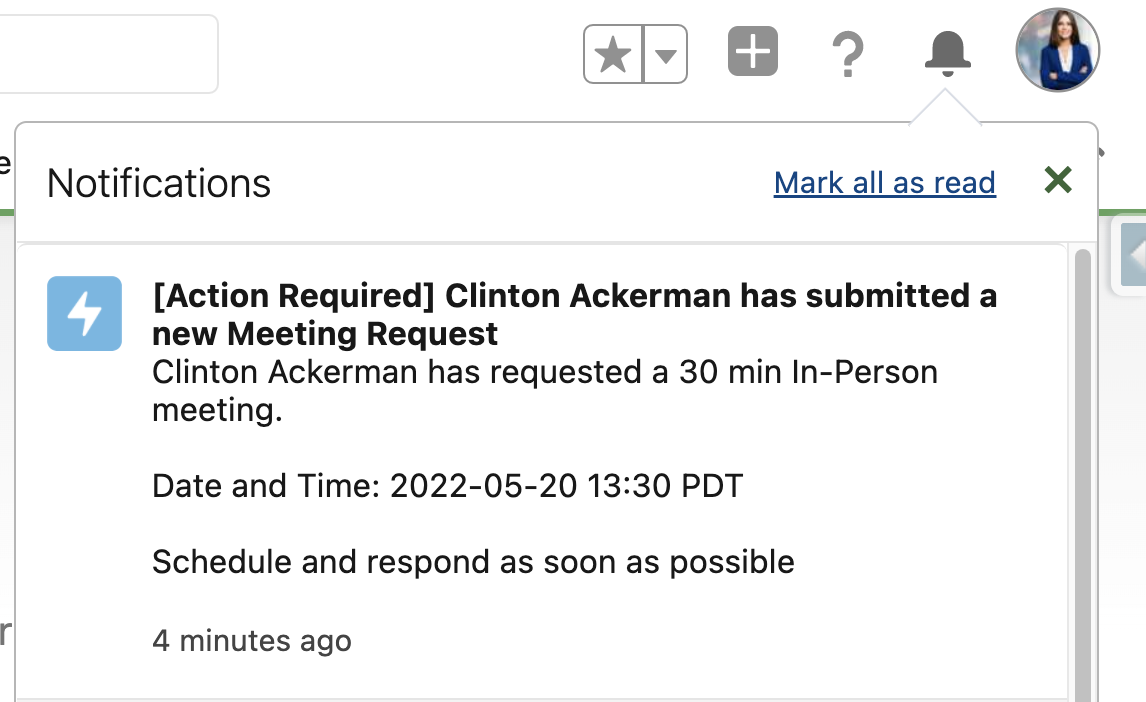
- Activate the appropriate VMOCs for the Meeting_Request_vod object.
-
Add the {{schedulerLink}} token to the appropriate Email Templates, Email Fragments, or Template Fragments. This token should be added as the href property of an <a> tag so that content creators can control the text of the link that displays to users.
For example:
<a href="{{schedulerLink}}">Book a meeting.</a>
Each link is unique and can be used to create a single meeting request. Links expire 30 days after the email is sent.
Defining the Company Logo
Customers can also define an optional company logo to display in the top right of the header on the scheduling site:
- Navigate to Custom Settings in the Setup menu.
- Select Manage for Engage Settings.
- Select New to define default organizational level or profile-specific Engage Settings.
- Populate the COMPANY_LOGO_vod Engage Link setting with an externally hosted URL to the appropriate image.
Requesting a Meeting
When a recipient opens an Approved Email containing the {{schedulerLink}} token, the token renders as a link to the Engage Scheduling Site via Engage, enabling recipients using Engage to see and avoid potential scheduling conflicts when requesting a new meeting.
For example, Dr. Clinton Ackerman requests a meeting with Sarah Jones via the Engage Scheduling Site. Later that day, he receives another link to request a meeting with Ian Kehl. When Dr. Ackerman sees the available times to request a meeting, he sees the time he previously requested to meet with Sarah Jones. This helps Dr. Ackerman avoid accidentally creating a scheduling conflict when requesting a time with Ian Kehl.
To use the Engage Scheduling Site to schedule a meeting as a recipient:
-
Select the link rendered by the {{schedulerLink}} token. The browser site renders in the viewer’s browser language and is available in all Veeva supported languages. If the view is using a language that is not supported by Veeva, the browser language defaults to English.
If recipients select the link on a device with the iOS or Android Engage app installed, the app opens and the recipient creates the meeting request from within the application. Recipients without the app installed can continue via the browser to create the meeting request there.
-
Select one of the meeting types:
- In-person
- Video
- Phone
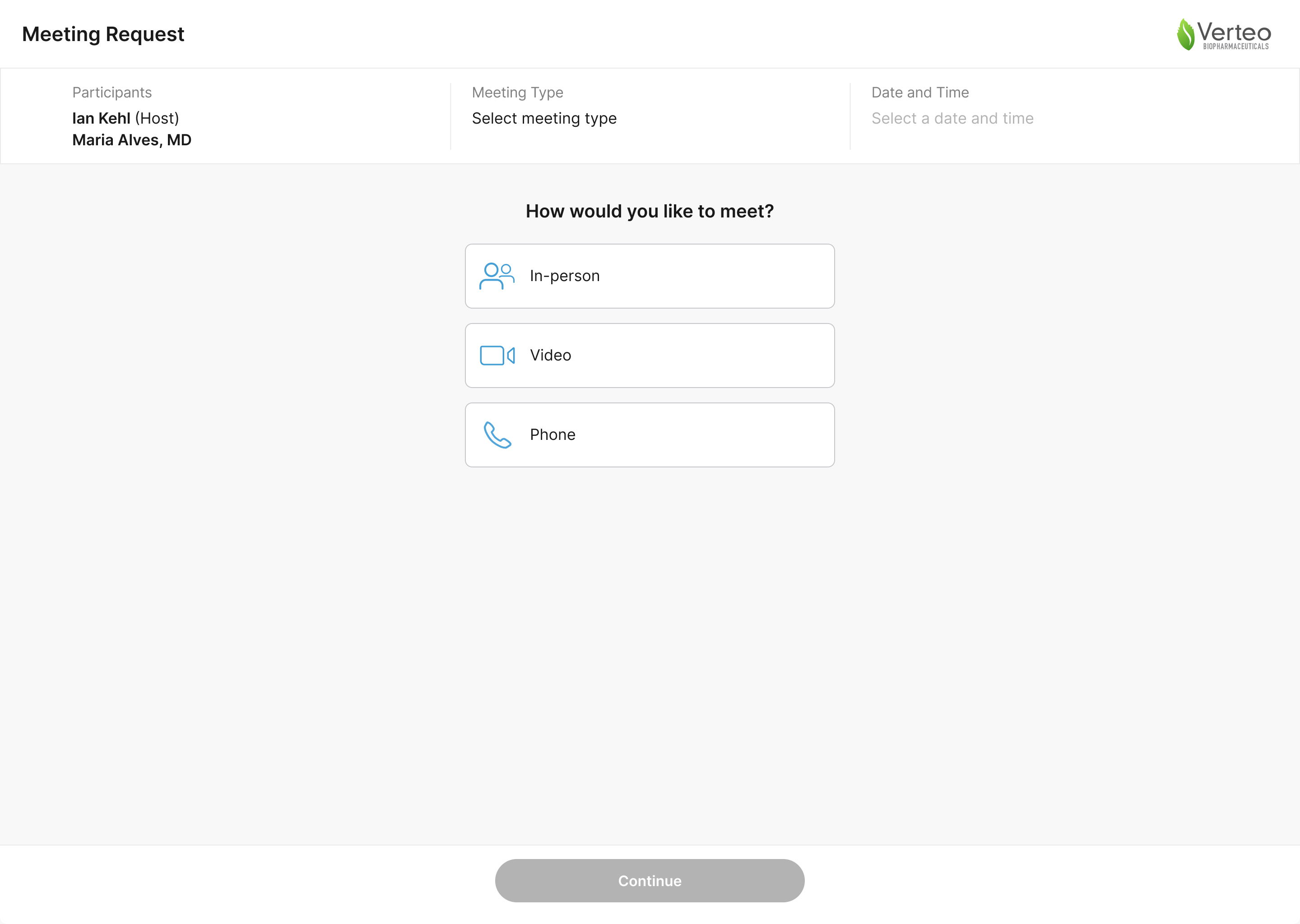
When users accept meeting requests, the Call_Channel_vod field is automatically populated based on the meeting type the HCP selects on the Engage Scheduling Site. The meeting type options are not configurable.
If the recipient selects In-person for the meeting type and has associated offices in Engage, they can optionally select an office to associate with the request.
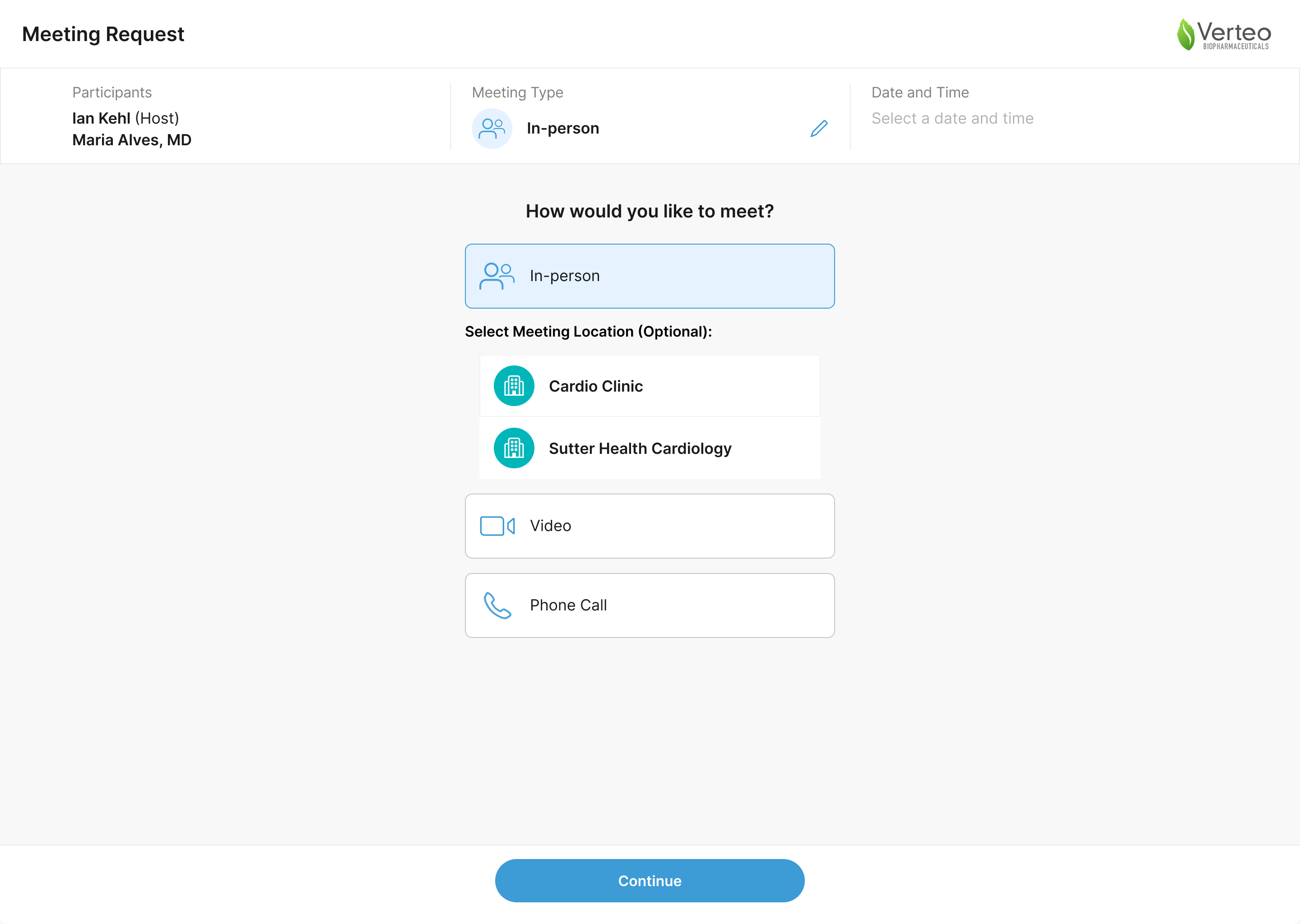
-
Select the desired time and date for the meeting. Recipients can request meetings up to 90 days in advance.
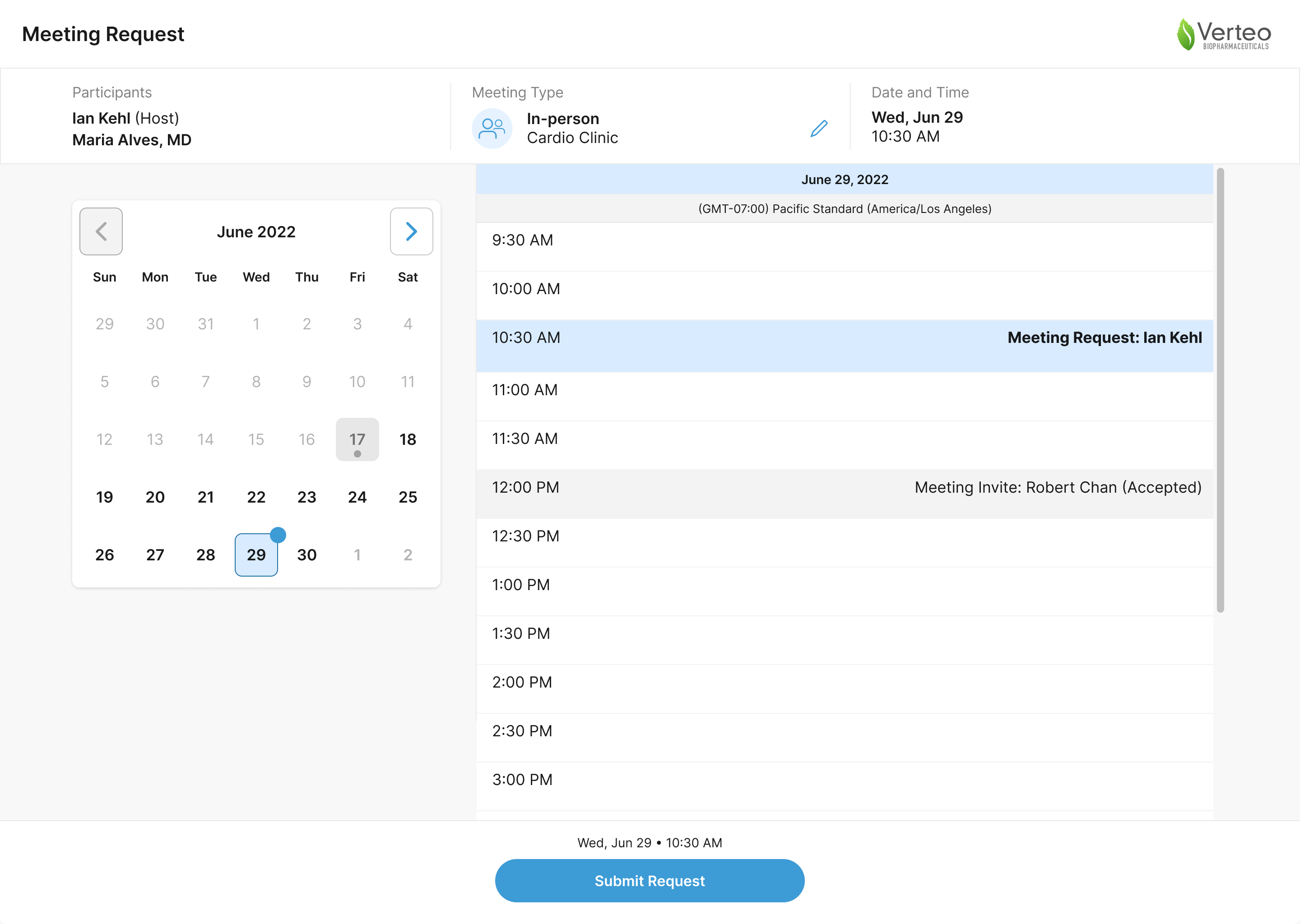
Recipients can change the requested meeting type at any point in the scheduling process. On mobile devices, select the back arrow in the header. On browser, select the pencil button next to the Meeting Type in the header.
-
Select Confirm. A confirmation message displays containing the meeting request information.

Notifying Users About Meeting Requests
When a recipient requests a meeting using the Engage Scheduling Site, a Meeting_Request_vod record owned by the sender of the Approved Email is created in CRM with the following values:
- Assignee_vod – The user who sent the email containing the link to the Engage Scheduling Site
- Account_vod – The recipient of the Approved Email who requested the meeting
- Owner – The user who sent the email containing the link to the Engage Scheduling Site
- Invitee_Display_vod – The Formatted_Name_vod field of the recipient account
- Meeting_Type_vod – The recipient’s selected meeting type. May be one of the following possible values:
- In-Person
- Video
- Phone
- Status_vod – Always populates as Requested_vod
- Start_DateTime_vod – The date and time requested by the recipient
- Duration_vod – Always populates as 30
- Sent_Email_vod – The Sent_Email_vod record sent to the recipient containing the {{schedulerLink}} token
- Phone_vod – Populates if the recipient entered a phone number after selecting Phone as the meeting type
In addition to the created Meeting_Request_vod record, users receive an email from scheduling@veevacrm.com stating a recipient requested a meeting, along with a prompt to respond and schedule the meeting as soon as possible.
For example, when Dr. Ackerman requests an In-person meeting with Sarah Jones, she receives the following email:
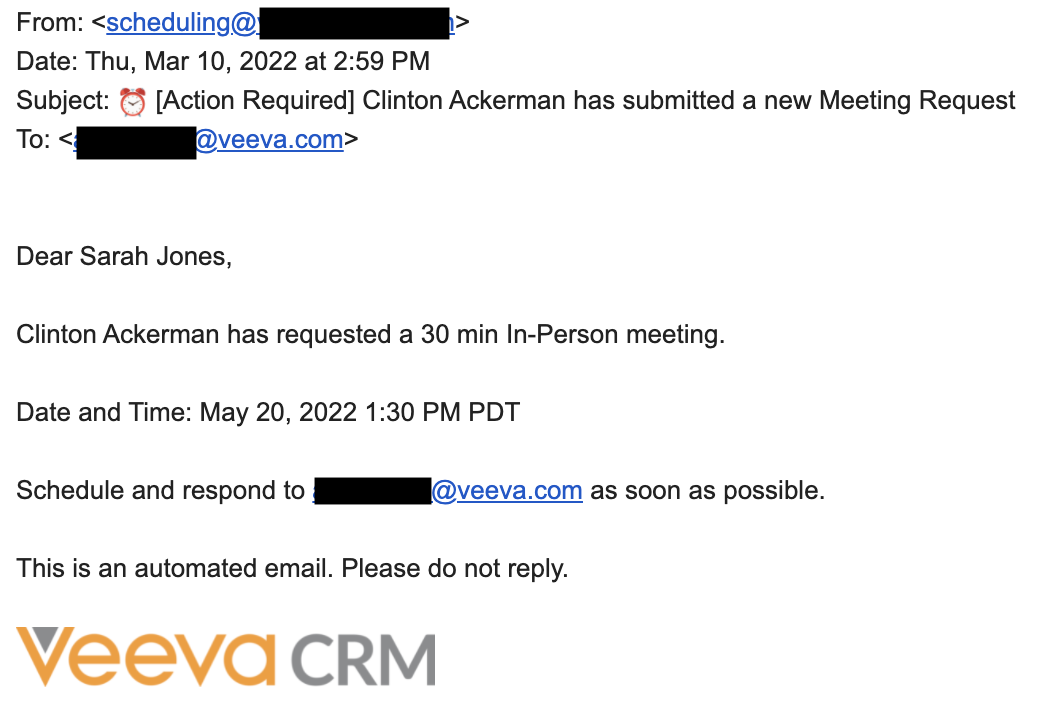
Users on the Browser platform also receive a notification when a new meeting request is created and assigned to them. If a user is not specified in the Assignee_vod field on the Meeting_Request_vod record, the notification goes to the record Owner instead.




